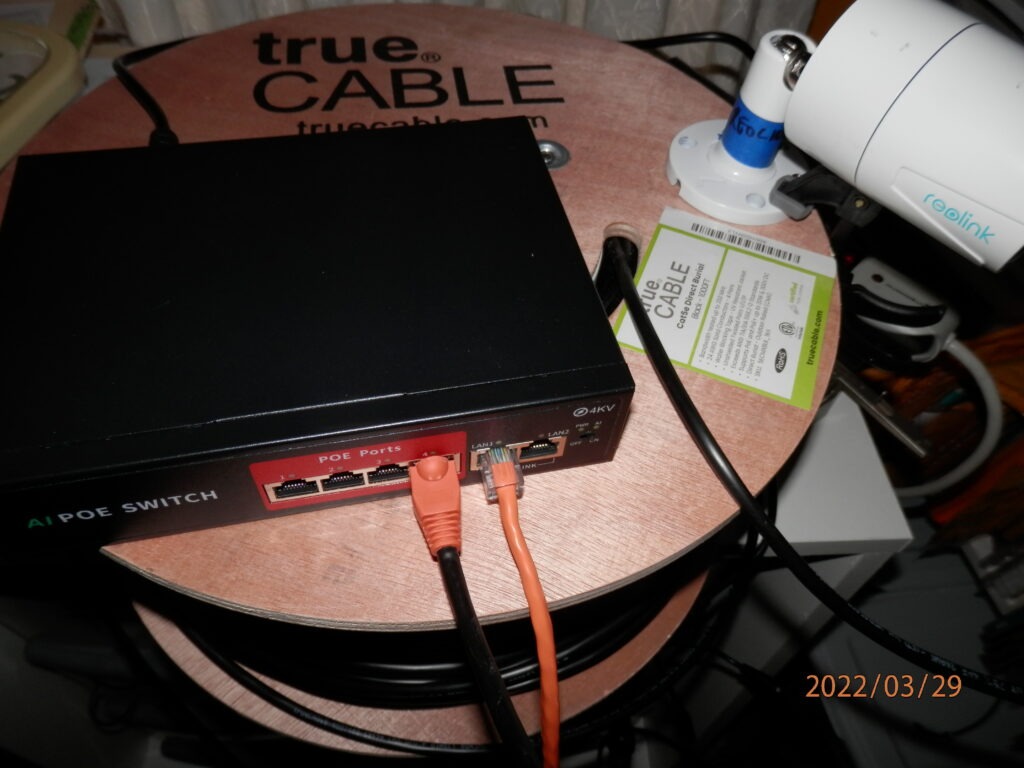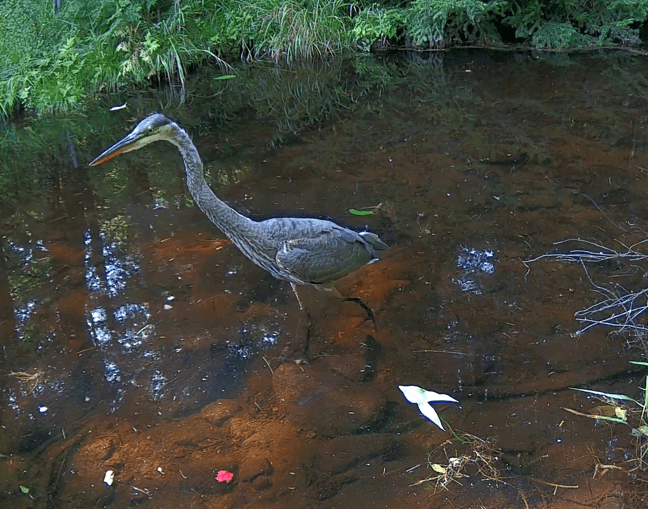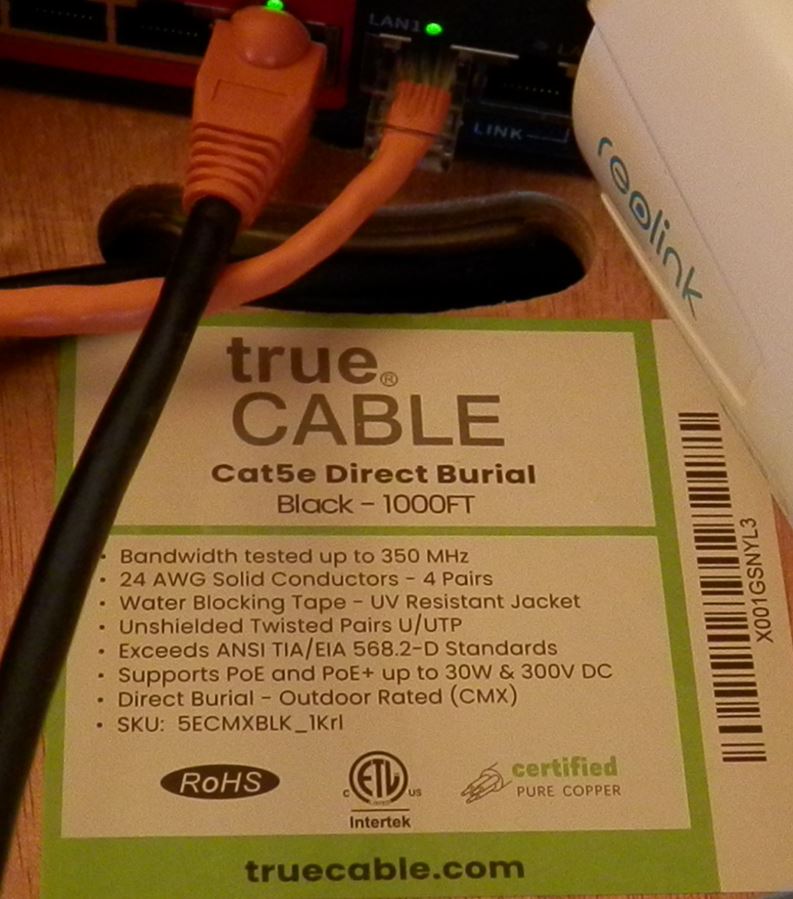
I have multiple IP cameras at my Newcomb Adirondack cabin. I am extending coverage along a stream as this is a focus for wildlife activity. So now I am now trying to install cameras that are more than the 300 ft from the nearest power source for router-switches. This exceeds the three hundred feet specified maximum unamplified transmission distance in ethernet cables.
Sending IP video streams more than 300ft down ethernet cables
I am working on sending an IP video signal over more than the specified 300ft ethernet transmission limit. The supposed standard for ethernet cable transmission is 100M or 330ft for a single throw with no amplification by a router or router switch. You can’t buy cables with RJ45 connectors for throws over 300ft. I know someone who extended somewhat beyond that using cable connectors, but the waterproof connector units are a point of failure for outdoor cables. My internet access out into the world is good as it is NY-sponsored fiberoptic from SLIC at my Newcomb cabin and Spectrum coaxial at home. The aim here is to get the signal into the Blue Iris and Reolink management software.
Exceeding the 300ft range for unamplified signals in internet cables

When the video stream from 4MP Reolink POE IP cameras with 300ft outdoor cables is acting up I have some success using no-name (Chinese brand) POE router-switches with an option to flip a switch to drop the data rate. A snag is that these come and go on Amazon in contrast to, say TP-link or Netgear branded offerings, sometimes you can rebuy the same thing, other times you are buying the same brand with a different spec or an alternate brand. I also like that no-name units have four usable device ports (in addition to a link back to the main hub) because they are cheap (around $30) and I can run multiple units so that a failure of one in winter doesn’t disable the whole network at my cabin where stuff has to run untended in the deepest months of winter.
A thousand foot ethernet cable works (barely)
I need to go a bit over 300ft for a couple of wildlife IP cameras this season. This post is a real world assessment, I’m not checking packet loss or voltage/power losses.

I bought a thousand foot drum of outdoor CAT5. Usually I shop for the cheapest cables but this time I was careful about the specification, this was True Cable brand and bought on ebay (watch the shipping cost – this stuff is heavy, 22 lb.). I bought cable that has 24 gauge solid copper wires and not copper covered Aluminum which may have bigger power loss over distance (not so sure about data transmission). I also bought cable crimps to add my own connectors. For this test I’m using the full reel but I expect to cut the cable down to what I need (a 400-500 foot run, plus a bunch of pieces).
Testing a 1000 foot Ethernet cable for internet IP camera video feeds
Yes I can get a usable internet signal down the full 1000ft cable supporting a camera installation, but its iffy,
For the cameras I think that limitations (for my combination of components) relate more to data than power. This is with power over ethernet, without using a separate power pack for the camera. Basic power transmission doesn’t seem to be an issue with 1000 ft. of the cable-brand I’m using. I seem to consistently get the IR lights of a shaded camera to come on, even when video was not coming through. I used a ReoLink 4MP RLC-410 camera in the YouTube video as the image source and the output (including the audio) was passed down the cable + router switch. The videos were initially recorded in Blue Iris so the video is the demonstration that 1000ft transmission is possible.
A thousand feet is beyond a sensible length of ethernet cable for data

I Spent a couple of hours playing and or various routers I could inconsistently access the internet when I hooked up PCs. Jacked into my main Netgear Nighthawk router I could see the port light was amber (if on at all). This indicated a 100 or 10 MBS speed (reduced from a white gigabit rating). It seemed bizarre that I could use Blue Iris software to integrate and watch multiple cameras (some tries!). I think I had better success doing a 1000ft main router to router switch and then a short line to the PC rather than having a thousand-foot line jacking directly jacking into the PC but getting a signal was inconsistent. So this is feasible but neither guaranteed nor recommended.
My main purpose is long outdoor links for IP cameras back to my cabin network. Using the 4 port POE router as the link to a Reolink RLC410 camera I had success in getting a color image into the Reolink viewer and into Blue Iris software via the 1000’ cable. This was with the router ‘AI’ switch engaged to reduce data speed (and maybe also the way power is assigned).
The take home message is that its possible to push a signal out 1000 feet but its not an optimal solution and not guaranteed to function. I’m posting about my experience because the amount of information available on long distance transmission above 300ft is limited.
Real world use of long ethernet cables over 300 ft. for video transmission
This post is a work-in-progress, I will add more when I have chopped the cable into pieces and am working with a more reasonable length – say 500ft. I get the impression that latching on to the feed may be a challenge for software – additional to maintaining the feed.
Sending 4 megapixel data on 350ft & 650ft CAT5 cables
We aren’t in Adirondack spring yet, but I was able to get out and measure off a long run of cable for cameras at my cabin. I rolled out cable from the spool then measured it. I figure that I cut a 350ft length for a new camera. That is modestly over the ~300ft specification for unamplified signals, and the remainder on the reel is say 650ft which is more of a challenge. I brought the cables home to attach RJ45 connectors and did a test with a Reolink RLC-410 camera.
The video feed from the camera looks fine for both lengths of cable, which is my acid test for usability but also the router switch lights are all green, so the camera hasn’t dropped to a lower speed (with an orange indicator light). The final test will be to string the cable outside and see if it supports an additional camera stream for my cabin.



